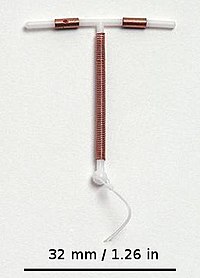
Photo from wikipedia
BACKGROUND Clinical guidelines support inpatient postpartum intrauterine device insertion; however, inpatient placement remains infrequent, in part due to inconsistent private insurance reimbursement. OBJECTIVE The purpose of this study was to… Click to show full abstract
BACKGROUND Clinical guidelines support inpatient postpartum intrauterine device insertion; however, inpatient placement remains infrequent, in part due to inconsistent private insurance reimbursement. OBJECTIVE The purpose of this study was to explore how the payer's costs and number of unintended pregnancies associated with postpartum intrauterine device differed on the basis of placement timing. STUDY DESIGN Using a decision tree model, following a hypothetical cohort of people who intend to use an intrauterine device after their delivery, we conducted a cost analysis comparing planned approach of inpatient versus outpatient postpartum insertion. Using a two-year time horizon, probability and cost estimates were derived from literature review. Our primary outcome was total accrued costs to the payer. Secondarily, we examined rates of early repeat pregnancy, and sensitivity to estimates of key inputs including expulsion rates and intrauterine device cost. RESULTS While inpatient intrauterine device placement's up-front costs were higher, total cost of this approach was lower. Including costs of managing expulsions and complications, our model suggests that for every 1000 people desiring postpartum intrauterine device, intended inpatient intrauterine device placement resulted in a total cost savings of $211,100 and prevention of 37 additional pregnancies as compared to outpatient placement. Inpatient cost savings were superior to outpatient largely due to a known high proportion not returning for outpatient placement, and the resulting higher number of unintended pregnancies among patients desiring outpatient placement. In sensitivity analyses, we found that total cost to the payer was sensitive to the probability of expulsion after immediate postpartum intrauterine device placement. CONCLUSIONS For beneficiaries desiring postpartum intrauterine device, payers are likely to save money by fully reimbursing inpatient intrauterine device placement rather than incentivizing placement at the frequently missed postpartum visit. These results support the financial case for private insurers to fully and separately reimburse (i.e. "unbundle" from the single payment for delivery) inpatient postpartum intrauterine device placement.
Journal Title: American journal of obstetrics and gynecology
Year Published: 2021
Link to full text (if available)
Share on Social Media: Sign Up to like & get
recommendations!